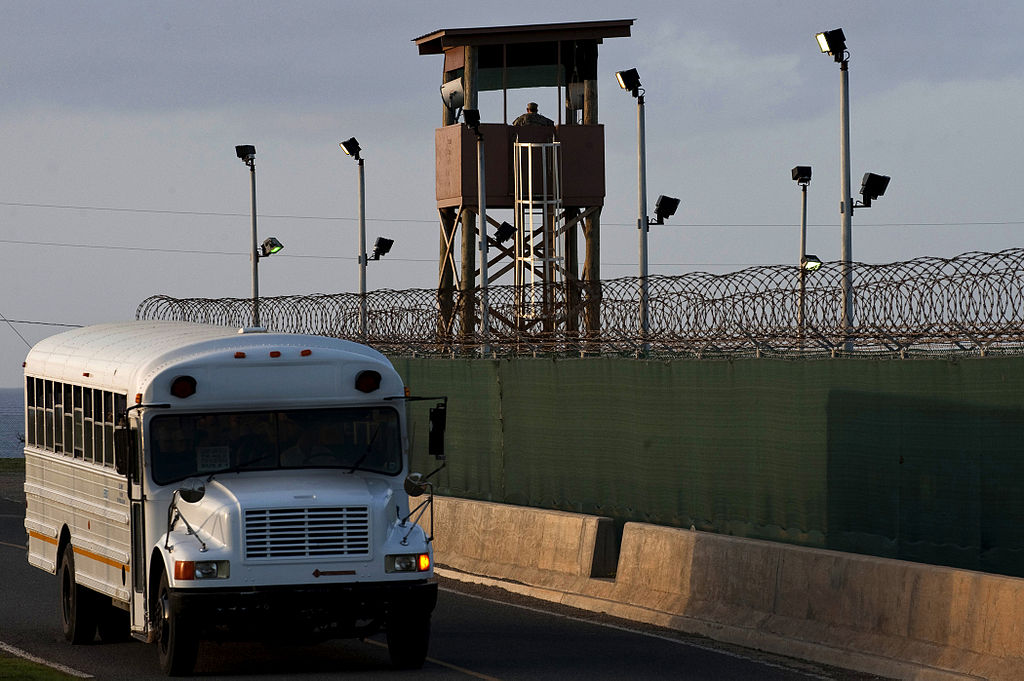Back to the Future on Detention and Military Commissions
President Trump still has not made good on his campaign promise to send bad hombres to Guantanamo, but thanks to a remarkable series of recent events, military detention of enemy combatants is back in the headlines anyways.

Published by The Lawfare Institute
in Cooperation With

President Trump still has not made good on his campaign promise to send bad hombres to Guantanamo, but thanks to a remarkable series of recent events, military detention of enemy combatants is back in the headlines anyways.
First, DOD officials surprised everyone seven weeks ago when they announced that an American citizen fighting with ISIS in Syria had been turned over to US custody. Since then we’ve learned only drips and drabs, but one thing is clear: efforts to put together a civilian criminal prosecution have run into an evidentiary brick wall, leaving continued detention—and therefore habeas litigation—a distinct possibility. Meanwhile, the White House proudly announced that US and Libyan forces have partnered to capture Mustafa al-Imam, another Benghazi suspect who will soon be in federal court facing charges.
The military commission process, for its part, has gone into full meltdown mode, with the defense team in the Al-Nashiri case attempting to withdraw from the case without the trial judge’s approval—a move that resulted in a contempt order yesterday that has left a JAG general under house arrest.
And as if that weren’t enough, a horrific terrorist attack in New York has spawned a new round in the on-again, off-again dispute regarding how terrorists inside the United States should be handled: a civilian prosecution, or a free trip to Guantanamo? For good measure, this time there was a remarkable twist: Even as the President and his White House spokesperson denounced our criminal justice system and favored the enemy combatant approach, the Justice Department and FBI—which at least nominally work for the President—were moving forward with the tried-and-true civilian prosecution option.
Let’s unpack it all, starting with a bit of background for those who might be overwhelmed by the crush of events.
Immediately following the attack on October 31, the White House released an official statement, offering general support to victims, their families, and first responders, and promising aid to law enforcement. On November 1, in a cabinet meeting, President Trump gave remarks and answered questions. Asked whether he wanted terror suspect Sayfullo Habibullaevic Saipov sent to Guantanamo Bay, Trump responded “I would certainly consider that. Send him to Gitmo —I would certainly consider that, yes.” The president also indicated that members of Saipov’s family “could” represent a threat to the country. He did not address whether Saipov was being considered an enemy combatant in these remarks.
In her November 1 press briefing, however, Sarah Huckabee Sanders responded to questions about the administration’s position on Saipov. She stated that while the president was not “advocating” sending Saipov to Guantanamo Bay, he would support doing so if he “felt like that was the best move.” She also confirmed that the administration considered Saipov an enemy combatant, though she indicated that no decision had been made about whether or not to charge him in federal court or deal with him somewhere else.
Sen. John McCain, meanwhile, issued a statement supporting the designation of Saipov as “an enemy combatant consistent with the Law of Armed Conflict,” and calling for him to be interrogated without being Mirandized. Sen. Lindsey Graham also weighed in, holding a press conference and releasing a written statement, supporting the idea of holding Saipov as an enemy combatant “for intelligence gathering purposes.” He did not indicate support for sending Saipov to Guantanamo Bay, but asserted that the option is available to the administration.
But even as all of this was going on, the government was moving forward on the criminal side. On the evening of November 1, the government filed a complaint in the Southern District of New York against Saipov, as though the President had not said a word. The complaint is, plainly, something of a placeholder. For now, Saipov is charged simply with one count of material support to a designated terrorist organization (ISIS) under 18 U.S.C. § 2339B, and one count of violence and destruction of a motor vehicle with reckless disregard for human life. The complaint describes the details of the attack, alleging that Saipov drove a flatbed truck in a bike lane and pedestrian walkway, killing eight people and injuring at least twelve others. Meanwhile, Saipov has been presented in federal court, at which point he certainly would have been Mirandized if he had not been Mirandized already.
The same day as all this happened, down at Guantanamo, the military judge in the Al-Nashiri case found Brig. Gen. John Baker, the man in charge of military commission defense teams, guilty of contempt of court for refusing to rescind the order excusing al-Nashiri’s civilian defense lawyers, sentencing him to 21 days of confinement in his quarters and to pay a $1,000 fine. The civilian defense attorneys had been excused after they raised not-publicly-specified ethical concerns related to attorney-client privilege. In yesterday’s contempt hearing, however, the judge ordered them to appear by means of video link to provide arguments for why they should be released from representing al-Nashiri. A Defense Department lawyer also filed a motion yesterday for a preliminary injunction to halt the Al-Nashiri proceedings, pending representation by qualified counsel.
And all of this unfolds even as an unnamed American detainee remains in U.S. custody abroad. Back in September, the U.S. citizen known as John Doe turned himself in to Syrian Democratic Forces. Two months later, he remains overseas, and is being held as an enemy combatant in Iraq, based on his role fighting for ISIS in Syria. John Doe is reportedly not cooperating with law enforcement, and the government has yet to release his name or give him access to counsel. On October 5, the American Civil Liberties Union (ACLU) filed a habeas petition on his behalf, on the claim that his detention was in violation of the Non-Detention Act (NDA). The government responded by challenging the ACLU’s standing as a next friend to the unnamed detainee. The government also argues, as a fallback position, that it is in any event too soon for any judicial intervention into the detention.
In some ways, the easiest piece of the picture to make sense of is the Saipov case: He’s not going to Guantanamo. The reasons are many. The evidence that he’s detainable under military authority is thin at best. According to the complaint, a number of ISIS images and videos were found on Saipov’s cellphone. When interviewed, he claimed to be inspired by these videos, particularly one that called on Muslims in the United States to act. But the government does not allege any direct contact with ISIS. Saipov appears, rather, to be a self-radicalized person inspired by ISIS but without—at least at this stage—appearing to be operating at its direction and control.
At least without more, this sort of mere sympathy would not appear to qualify under D.C. Circuit case law as being “part of” enemy forces. Even if it did, the last thing the military needs right now is an ISIS detainee who is going to get to litigate whether ISIS is really covered by the AUMF at all—a matter the John Doe case will also raise if it gets that far. By contrast, the criminal case against Saipov is both overwhelming and pretty easy. So the government faces a simple choice here between a difficult litigation both factually and legally or an open-and-shut multiple murder case in broad daylight. Trump and Sanders can say whatever they want, but the Justice Department and the Defense Department will act rationally. Indeed, the Justice Department appeared to be moving awfully quickly today, in the aftermath of the President’s comments, to put the formalities of prosecution into motion. And this morning, the President appeared to reverse course, tweeting that while he’d “love” to send Saipov to Guantanamo, the federal system was faster and appropriate before calling for the death penalty.
The John Doe case is murkier. The detainee is, for one thing, already in military custody. And while officials appear to want to bring him to the United States for trial—that is, transfer him to civilian custody—the Washington Post reports that they lack the evidence to do so. Moreover, the detainee has not cooperated with law enforcement to any degree, and the apparent absence of a transfer to his other country of citizenship (whatever country may turn out to be) is conspicuous enough to suggest that this may not be an option either for some reason. So the government is simply continuing to hold him in military detention in Iraq, while also attempting to hold off the ACLU in court at least long enough to buy itself enough time to figure out a disposition that is lawful and that prevents him from posing a threat in the future.
The effort at delay is itself raising concerns. On the one hand, officials are withholding the detainee’s name from the public (thus precluding the ACLU or anyone else from offering services for the detainee through the detainee’s family) and rejecting the detainee’s own apparent request for counsel. At the same time, the government is arguing in court that the ACLU, which has filed a habeas petition on his behalf, is not a proper next friend given its lack of authorization from the family. The government’s dilemma in sorting out what to do with John Doe may be a bind not of its own making, but stalling in a manner that in theory would defeat a citizen’s habeas rights is not sustainable.
Further beclouding things is the extraordinary turn of events in the Guantanamo military commissions. Just as the al-Nashiri litigation (involving the bombing of the USS Cole) seemed to be heating up, allegations of government surveillance of the defense team’s attorney-client communications led the civilian members of that team—including the sole capital punishment expert on the team—to assert that they cannot continue in the representation without violating their ethical obligations. They thus sought permission from the JAG general in charge of the overall defense office to withdraw, and General Baker granted their request. This threatened to derail the entire prosecution, and perhaps others as well—including the 9/11 case—should other defense attorneys make a similar determination. The presiding judge in the commission proceeding against al-Nashiri certainly saw it that way, and disputed the notion that the defense team could withdraw without his approval. He therefore convened a contempt hearing yesterday, and the next thing you know, General Baker was held in contempt of court and confined to house arrest in the nearby trailer that serves as his quarters at Guantanamo. That order is now before the Convening Authority, Harvey Rishikoff, but one can expect there will soon be a collateral attack, perhaps by habeas petition, soon as well. There’s also a hearing this morning before Judge Lamberth in the federal district court in DC on Nashiri’s motion to halt the commission proceedings. It’s one more cloud, in any rate, hovering over the commissions process even as the President of the United States goes out of his way to denounce the speed and reliability of the civilian criminal justice system.
What does it all mean? A few observations are in order.
First, very little of this is really about Donald Trump, though discomfort with the Trump Presidency is certainly conditioning people’s responses to it. The problem raised by the John Doe detainee—that is, a citizen detainee who cannot easily be prosecuted but who cannot be easily released either—could have arisen any time. Indeed, we have been expecting it for years.
The military commissions meltdown, meanwhile, is part of a long history at Guantanamo at which defense lawyers stake out theatrical positions designed to bring discredit on the entire enterprise of military commissions—and the system struggles to adjust. This episode would have happened no matter who was President.
And as to Saipov, the battle here is also familiar. Every time an alleged terrorist gets arrested on U.S. soil, Lindsey Graham and John McCain advocate for treating him as an enemy combatant—and the Justice Department treats him as a criminal defendant. The only novelty here is that Trump jumped out on the side of the well-trodden debate opposite the position of his own administration.
In other words, while it’s easy to see these episodes as reflecting some broad shift of policy or push on the Trump administration’s part toward military authorities, they actually don’t reflect that. There has been no policy change either with respect to military commissions or with respect to military detention.
Second, the confluence of events is a reminder that there are big unresolved questions with respect to both military commissions and military detention. With respect to commissions, the question is what it has always been: Can the system be made to work? The answer is increasingly clear that it cannot—and that the effort is providing endless opportunities for litigation and theatrics that are not available to defendants in federal courts. With respect to military detention, the question also remains what it has ever been: how to govern the seam between civilian prosecution and military detention, both of which are legal options for certain detainees, when a potential detainee arguably qualifies for either. These questions faded from prominence during the Obama administration, because the United States’s detention footprint receded so dramatically. But they never went away. And they won’t go away as long as the country is conducting operations overseas that involve capturing people who are plausible both as military targets and as criminal defendants.
Finally, third, one question with respect to the seam between military and civilian custody that is resolved is what to do with terrorist suspects captured domestically. The Kabuki theater our society goes through every time we capture a suspect—in which we spasmodically debate holding the suspect as a military detainee, though there is no chance of that happening—really needs to stop. There are good reasons to treat such people as criminal suspects. There are no good reasons not to, even if the President and his spokeswoman don’t understand either the law or the policy equities at stake.






